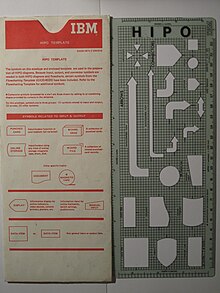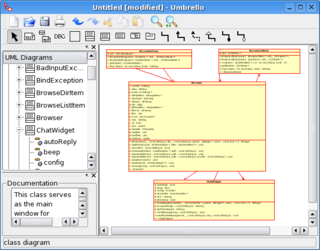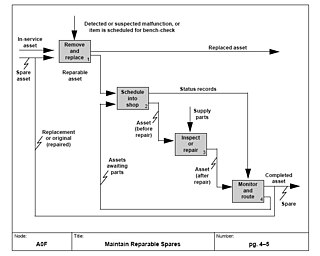
HIPO model (hierarchical input process output model) is a systems analysis design aid and documentation technique from the 1970s, [1] used for representing the modules of a system as a hierarchy and for documenting each module. [2] [3]

HIPO model (hierarchical input process output model) is a systems analysis design aid and documentation technique from the 1970s, [1] used for representing the modules of a system as a hierarchy and for documenting each module. [2] [3]
It was used to develop requirements, construct the design, and support implementation of an expert system to demonstrate automated rendezvous. Verification was then conducted systematically because of the method of design and implementation. [4]
The overall design of the system is documented using HIPO charts or structure charts. The structure chart is similar in appearance to an organizational chart, but has been modified to show additional detail. Structure charts can be used to display several types of information, but are used most commonly to diagram either data structures or code structures. [3]
Structured Query Language (SQL) is a domain-specific language used to manage data, especially in a relational database management system (RDBMS). It is particularly useful in handling structured data, i.e., data incorporating relations among entities and variables.
Software design is the process of conceptualizing how a software system will work before it is implemented or modified. Software design also refers to the direct result of the design process – the concepts of how the software will work which consists of both design documentation and undocumented concepts.

IDEF, initially an abbreviation of ICAM Definition and renamed in 1999 as Integration Definition, is a family of modeling languages in the field of systems and software engineering. They cover a wide range of uses from functional modeling to data, simulation, object-oriented analysis and design, and knowledge acquisition. These definition languages were developed under funding from U.S. Air Force and, although still most commonly used by them and other military and United States Department of Defense (DoD) agencies, are in the public domain.

A flowchart is a type of diagram that represents a workflow or process. A flowchart can also be defined as a diagrammatic representation of an algorithm, a step-by-step approach to solving a task.
Structured systems analysis and design method (SSADM) is a systems approach to the analysis and design of information systems. SSADM was produced for the Central Computer and Telecommunications Agency, a UK government office concerned with the use of technology in government, from 1980 onwards.

Computer-aided software engineering (CASE) is a domain of software tools used to design and implement applications. CASE tools are similar to and are partly inspired by computer-aided design (CAD) tools used for designing hardware products. CASE tools are intended to help develop high-quality, defect-free, and maintainable software. CASE software was often associated with methods for the development of information systems together with automated tools that could be used in the software development process.
Modular programming is a software design technique that emphasizes separating the functionality of a program into independent, interchangeable modules, such that each contains everything necessary to execute only one aspect of the desired functionality.

Business process modeling (BPM) is the action of capturing and representing processes of an enterprise, so that the current business processes may be analyzed, applied securely and consistently, improved, and automated.
A functional software architecture (FSA) is an architectural model that identifies enterprise functions, interactions and corresponding IT needs. These functions can be used as a reference by different domain experts to develop IT-systems as part of a co-operative information-driven enterprise. In this way, both software engineers and enterprise architects can create an information-driven, integrated organizational environment.
Object-oriented analysis and design (OOAD) is a technical approach for analyzing and designing an application, system, or business by applying object-oriented programming, as well as using visual modeling throughout the software development process to guide stakeholder communication and product quality.

Structured analysis and design technique (SADT) is a systems engineering and software engineering methodology for describing systems as a hierarchy of functions. SADT is a structured analysis modelling language, which uses two types of diagrams: activity models and data models. It was developed in the late 1960s by Douglas T. Ross, and was formalized and published as IDEF0 in 1981.
Joint application design is a term originally used to describe a software development process pioneered and deployed during the mid-1970s by the New York Telephone Company's Systems Development Center under the direction of Dan Gielan. Following a series of implementations of this methodology, Gielan lectured extensively in various forums on the methodology and its practices. Arnie Lind, then a Senior Systems Engineer at IBM Canada in Regina, Saskatchewan created and named joint application design in 1974. Existing methods, however, entailed application developers spending months learning the specifics of a particular department or job function, and then developing an application for the function or department. In addition to development backlog delays, this process resulted in applications taking years to develop, and often not being fully accepted by the application users.

In software engineering, structured analysis (SA) and structured design (SD) are methods for analyzing business requirements and developing specifications for converting practices into computer programs, hardware configurations, and related manual procedures.

In software development, the V-model represents a development process that may be considered an extension of the waterfall model and is an example of the more general V-model. Instead of moving down linearly, the process steps are bent upwards after the coding phase, to form the typical V shape. The V-Model demonstrates the relationships between each phase of the development life cycle and its associated phase of testing. The horizontal and vertical axes represent time or project completeness (left-to-right) and level of abstraction, respectively.

In systems engineering, software engineering, and computer science, a function model or functional model is a structured representation of the functions within the modeled system or subject area.
A glossary of terms relating to project management and consulting.

A structure chart (SC) in software engineering and organizational theory is a chart which shows the breakdown of a system to its lowest manageable levels. They are used in structured programming to arrange program modules into a tree. Each module is represented by a box, which contains the module's name. The tree structure visualizes the relationships between modules.
The Cranfield experiments were a series of experimental studies in information retrieval conducted by Cyril W. Cleverdon at the College of Aeronautics, today known as Cranfield University, in the 1960s to evaluate the efficiency of indexing systems. The experiments were broken into two main phases, neither of which was computerized. The entire collection of abstracts, resulting indexes and results were later distributed in electronic format and were widely used for decades.
In software engineering, a software development process or software development life cycle (SDLC) is a process of planning and managing software development. It typically involves dividing software development work into smaller, parallel, or sequential steps or sub-processes to improve design and/or product management. The methodology may include the pre-definition of specific deliverables and artifacts that are created and completed by a project team to develop or maintain an application.
Low-level design (LLD) is a component-level design process that follows a step-by-step refinement process. This process can be used for designing data structures, required software architecture, source code and ultimately, performance algorithms. Overall, the data organization may be defined during requirement analysis and then refined during data design work. Post-build, each component is specified in detail.